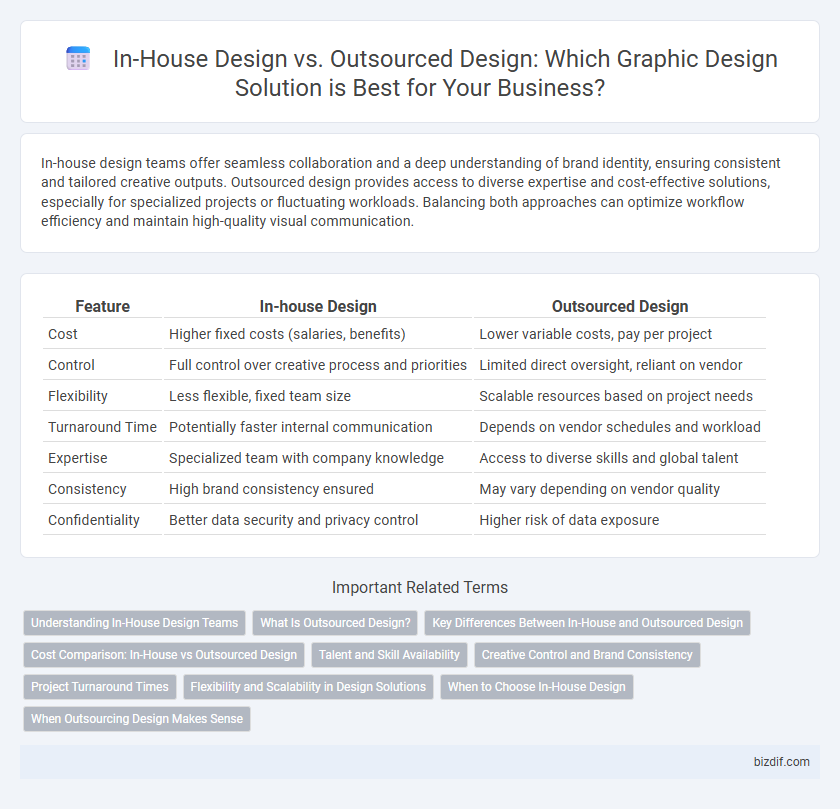In-house design teams offer seamless collaboration and a deep understanding of brand identity, ensuring consistent and tailored creative outputs. Outsourced design provides access to diverse expertise and cost-effective solutions, especially for specialized projects or fluctuating workloads. Balancing both approaches can optimize workflow efficiency and maintain high-quality visual communication.
Table of Comparison
| Feature | In-house Design | Outsourced Design |
|---|---|---|
| Cost | Higher fixed costs (salaries, benefits) | Lower variable costs, pay per project |
| Control | Full control over creative process and priorities | Limited direct oversight, reliant on vendor |
| Flexibility | Less flexible, fixed team size | Scalable resources based on project needs |
| Turnaround Time | Potentially faster internal communication | Depends on vendor schedules and workload |
| Expertise | Specialized team with company knowledge | Access to diverse skills and global talent |
| Consistency | High brand consistency ensured | May vary depending on vendor quality |
| Confidentiality | Better data security and privacy control | Higher risk of data exposure |
Understanding In-House Design Teams
In-house design teams offer direct collaboration and immediate communication, ensuring brand consistency through a deep understanding of company values and goals. These teams have the advantage of faster turnaround times and easy access to internal stakeholders for feedback and adjustments. Maintaining design in-house enhances control over creative processes and allows for tailored solutions that reflect the company's unique identity.
What Is Outsourced Design?
Outsourced design refers to hiring external agencies or freelance designers to handle graphic design projects rather than relying on an internal team. This approach allows companies to access specialized skills, scale resources based on project demands, and reduce overhead costs associated with full-time staff. Outsourcing can improve efficiency and bring diverse creativity by leveraging global talent pools in graphic design.
Key Differences Between In-House and Outsourced Design
In-house design teams provide direct control over creative processes, fostering immediate collaboration and alignment with company culture, while outsourced design offers cost efficiency and access to specialized expertise across diverse industries. In-house design ensures faster communication and brand consistency, whereas outsourced design delivers scalability and flexibility for fluctuating project demands. Key differences include budget allocation, project turnaround time, and the degree of creative control retained by the organization.
Cost Comparison: In-House vs Outsourced Design
In-house design teams require fixed salaries, benefits, software licenses, and equipment, resulting in higher upfront costs but greater control over the creative process. Outsourced design offers variable pricing models such as project-based or hourly rates, often reducing overhead and enabling access to specialized skills for specific tasks. Comparing total expenditure involves analyzing project scope, frequency, and quality requirements to determine which approach offers the best cost-efficiency aligned with business goals.
Talent and Skill Availability
In-house design teams offer direct access to specialized talent with a deep understanding of the company's brand and vision, ensuring consistent and tailored creative output. Outsourced design provides a broader pool of skilled professionals with diverse expertise, enabling quick scalability and exposure to innovative techniques. Balancing talent availability depends on project scope, budget constraints, and the need for specialized skills versus brand alignment.
Creative Control and Brand Consistency
In-house design teams offer unparalleled creative control by enabling immediate feedback and seamless collaboration, ensuring brand consistency across all visual materials. Outsourced design can introduce innovative perspectives but risks misalignment with core brand values due to limited direct oversight. Maintaining brand consistency relies heavily on clear communication and defined brand guidelines regardless of the design approach chosen.
Project Turnaround Times
In-house graphic design teams often achieve faster project turnaround times due to immediate access to resources and streamlined communication within the company. Outsourced design services may experience delays from client-vendor coordination, time zone differences, and revision cycles, extending the overall timeline. Companies seeking rapid project completion typically benefit from in-house design departments that can adapt quickly to evolving requirements and deadlines.
Flexibility and Scalability in Design Solutions
In-house design teams provide greater flexibility by enabling rapid adjustments and immediate collaboration tailored to specific brand needs, facilitating consistent creative control. Outsourced design offers scalability by accessing diverse talent pools and specialized skills on demand, allowing businesses to quickly expand or reduce project scope without long-term commitments. Balancing in-house expertise with outsourced resources can optimize flexibility and scalability, ensuring dynamic design solutions aligned with evolving business goals.
When to Choose In-House Design
In-house design is ideal when a company requires consistent brand alignment, rapid turnaround times, and direct oversight of creative processes, ensuring designs closely reflect internal goals and culture. Choosing in-house teams benefits projects demanding frequent updates and confidential handling of sensitive or proprietary information. This option also fosters better collaboration between designers and other departments, enhancing overall workflow efficiency and innovation.
When Outsourcing Design Makes Sense
Outsourcing graphic design makes sense when specialized skills or fresh perspectives are needed beyond the in-house team's expertise, particularly for projects requiring advanced animation, 3D modeling, or international market adaptation. Cost-effectiveness is another critical factor, as hiring external agencies or freelancers can reduce expenses related to salaries, benefits, and training, especially for short-term or variable workloads. Companies scaling rapidly or facing tight deadlines benefit from outsourcing to access flexible resources and accelerated project turnaround without overburdening internal staff.
In-house design vs Outsourced design Infographic

 bizdif.com
bizdif.com